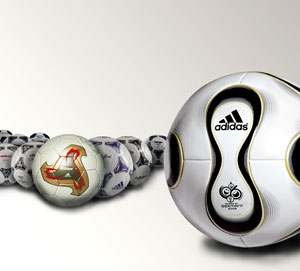England will play Portugal in the World Cup quarterfinals on Saturday night, but it might come down to goalkeeper Paul Robinson versus Teamgeist — the new World Cup ball.
The ball has drawn criticism from a number of goalkeepers for its unpredictable movement in the air. Robinson told BBCSport the ball was "very goalkeeper unfriendly" and that it moves "about all over the place". And goalkeepers are not the only ones commenting on the Teamgeist's design: scientists agree that it could cause some upsets in this year's competition.

The Teamgeist has a distinctly different construction than past footballs, with only 14 panels.
Teamgeist (which means team spirit in German) has a very unusual construction consisting of just 14 curved panels wrapping around the football. This is a dramatic change from the 32 panel (12 pentagons and 20 hexagons) balls used in the World Cup since 1970.
Adidas, who created the Teamgeist for the World Cup, say their design gives the ball an almost perfectly spherical shape and makes it the most accurate ball ever. But scientists claim that in certain instances, this smoother shape could make the ball wildly unpredictable in flight because of the aerodynamics of its design.
Dr Ken Bray, a sports scientist at the University of Bath, studies the aerodynamics of footballs in flight. The movement of a ball through the air can be described by differential equations, one equation for each of the three dimensions. The basis for this description are the Navier-Stokes equations, which describe the behaviour of any fluid, and are used in many applications such as weather prediction.(You can read more about the Navier-Stokes equations in How maths can make you rich and famous from issue 25 of Plus, and about weather prediction in And now, the weather....)
These complicated equations cannot be easily solved, but Bray can find approximate solutions which explain the behaviour of a ball in flight. And the findings from Bray's research indicate there may be a mathematical truth behind Robinson's concerns about the Teamgeist — the ball is not aerodynamically stable.
When a ball is kicked slowly, the airflow separates from the ball leaving a large zone of turbulence behind it, creating drag which slows the ball down. But over a certain speed, 12mph for a football, the airflow sticks to the surface of the ball for longer, and this late separation results in less turbulence and reduced drag. This thin layer of airflow clinging very close to the surface of the ball is called the boundary layer. When the boundary layer is created, or "tripped", the ball will move in a much more predictable way. (You can read more detail about tripping the boundary layer in Bray's article The science behind the swerve on the BBC.)
It is now understood that surface imperfections, such as the seams on a football, contribute to the boundary layer being tripped: more imperfections result in improved aerodynamic stability. However the Teamgeist's 14 panels gives it less seams than other footballs, and this is the factor that makes Bray fear for Robinson and his goalkeeping peers.
It appears that the boundary layer is tripped by discontinuities being present on particular sections of the ball as it moves during its flight. This is not a problem if the ball is spinning quickly enough — the quick rotation means that, on average, a seam will be where needed to trip the boundary layer more or less continuously.
"Because the Teamgeist ball has just 14 panels it is aerodynamically more similar to the baseball which only has two panels," Bray says. And what goalkeepers have to watch out for is the equivalent of baseball's knuckleball — when the ball has very little spin at all. Due to the fewer seams on the Teamgeist, they may move in and out of the right location to trip the boundary layer, so the ball will veer between stable and unstable movement in the air.
"Occasionally pitchers will throw a 'knuckleball' which bobs about randomly in flight and is very disconcerting for batters. It happens because pitchers throw the ball with very little spin and as the ball rotates lazily in the air, the seam disrupts the air flow around the ball at certain points on the surface, causing an unpredictable deflection."
So if we're lucky (and Robinson or one of his peers isn't), we might see the first of a new breed of goal — the knucklegoal. "Watch the slow motion replays to spot the rare occasions where the ball produces little or no rotations," says Bray, "and where goalkeepers will frantically attempt to keep up with the ball's chaotic flight path."
But 14 panels or 32, with the best players from around the world in Germany this summer, we can look forward to many spectacular saves — as well as many spectacular goals.